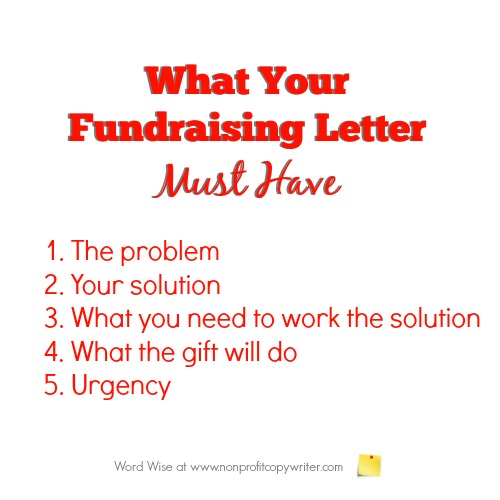Save Time: Get 5 Simple Writing Tips
you can put to use in 10 minutes
What Your Fundraising Letter Must Have
Award-winning writer Kathy Widenhouse has helped hundreds of nonprofits and writers produce successful content , with 750K+ views for her writing tutorials. She is the author of 9 books. See more of Kathy’s content here.
Updated 12.5.24
An effective fundraising letter contains certain key elements – pieces that must be included in order to accomplish its goal of persuading the reader to give.
While this list is not a template, it offers a good sequential order to follow in a fundraising letter body.
Not every letter will follow this formula exactly. This particular order is simply a logical one to follow.
In fact, each of the elements is 100% necessary. Use these 5 valuable tips as you write your next appeal letter.
What Your Fundraising Letter MUST Have
1. The Problem
Your nonprofit exists to help fix a problem. What is it? (See What Makes You Unique.) Don’t assume your reader has thought about the problem one iota. Explain to him what the issue is and outline clearly what needs to change. Do you help at-risk children with an after-school program? Point out what happens when children don’t have somewhere to go after school. Paint a picture of an at-risk composite child you serve. Provide statistics to support your case.
2. Your Solution
How does your nonprofit alleviate this particular issue? Why is your nonprofit the best (or most accessible, most effective, most economical, most whatever) way to solve this problem? Here is where you outline the particular program for which you’re raising funds. Use the content you developed in your strategic plan as a starting point. Why does this program work and work well to fix the problem? Provide your track record.
3. What You Need
Don’t make the mistake of assuming your fundraising letter can be a one-size-fits-all. Set a concrete goal for your readers - one they can get their minds around. This is important because nonprofit work is notoriously subjective, often working to “change lives.” Prospects need and want to understand the actual dollar amount you need to receive during this specific campaign in order to carry out the designated project. If your appeal is to help meet the general budget, then tie it to a percentage of your current fiscal year. A tangible campaign goal (“We need to raise $47,290 by June 30, our fiscal year end, to meet our obligations”) offers objectivity. (More about Writing an Ask).
4. What the Gift Will Do
It’s not enough to assume a donor will simply give because it’s the right thing to do. What will the donor’s gift accomplish? You must connect the dots for him. Show how his gift will help solve the problem (in nonprofit-speak, explain how it will “fulfill your mission.”) The gift must accomplish something specific such as, “Your gift of $50 will provide food and clean water for 1 child for two weeks during this horrific famine.”
5. Urgency
Why give now? What will happen if the prospect doesn’t get his checkbook out this instant? Use urgent language such as “now” or “as soon as possible.”
Offer a deadline, whether it’s for a matching grant, year-end campaign, a specific project, or a natural disaster emergency that requires immediate relief.
More on Writing Appeal Letters
Free Download: a Simple (and Powerful) Fundraising Letter Template ...
5 Opening Lines for Fundraising Messages ...
3 appeal letter copywriting formulas ...
6 elements in a successful appeal letter writing format ...
Fundraising Ask Secrets: how to propel prospects to give ...
Two writing tips for making the ask ...
Avoid the most common appeal letter trap ...
How to write a P.S. with punch ...
Your year-end appeal fundraising checklist ...
Call to action: have you told your reader what to do?
Write a Call to Action in 3 words or less ...
A tale of two envelope carriers ...
More tips about fundraising writing ...
Return from What Your Fundraising Letter Must Have to Nonprofit Copywriter home
As an Amazon Associate I earn from qualifying purchases.
Share This Page

Named to 2022 Writer's Digest list
BEST GENRE/NICHE WRITING WEBSITE


Stop Wasting Time!

Grab your exclusive FREE guide, "5 Simple Writing Tips You Can Put to Use in 10 Minutes or Less"











